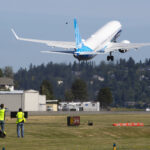Since the early phases of its construction in 1993, the City of Denver and Denver County have been aware that the United Airlines concourse of Denver International Airport (DIA) has been contaminated by toxic deicing fluids, raw sewage, mold and noxious fumes that have made hundreds of concourse workers sick, yet Denver has failed to clean up the terminal or affect changes to prevent future contamination, according to a lawsuit filed there this week.
The lawsuit brought against the city, the county and DIA by Denver- and Chicago-based law firms and current and former United employees, states that the U.S. Department of Labor Occupational Safety and Health Administration (OSHA) and the city’s own environmental consultants have performed several investigations and found contamination and potential health threats.
According to Michael Duffy, partner with the Chicago law firm of Childress Duffy Goldblatt Ltd, and John Fognani, partner with the Denver law firm of Fognani Guibord & Homsy LLP hundreds of employees have complained for years of health problems ranging from nausea and dizziness to respiratory inflammation and other symptoms caused by working in the B concourse. One of the primary dangers, they say, lies in the poor design of DIA’s system for reclaiming potentially toxic deicing fluids, but other factors also contribute to the concourse’s contamination.
“Of approximately one million gallons of deicing fluid used at DIA, approximately 250,000 gallons of fluid are not reclaimed, and we believe the majority of this contaminant, as well as large quantities of maintenance chemicals and fuels, continue to make their way back to the concourse,” Duffy said. “This is complicated,” he added, “by the fact that raw sewage seems to be also leaking into the soil around the concourse and, ultimately, into Concourse B. We have been contacted by hundreds of workers who have been complaining of these problems for years, and the City just doesn’t seem to want to address their complaints. Concourse B must be cleaned up,” he said.
Fognani added: “In addition to the initial dangers presented by the chemical cocktail leaking into the concourse, the various chemicals also have the potential to give off toxic vapors as they degrade.”
Fognani stated that the contaminated runoff has also created a significant mold problem.
“Mold has grown in the saturated drywall of employee facilities throughout the concourse, in the walls of several United Airlines’ training rooms, the men’s and women’s locker rooms and the mail sorting facility,” he said. “We are particularly concerned that the city, by failing to stop the chemical leakage, has allowed potentially hazardous mold to colonize Concourse B heating, ventilation and air conditioning systems, which has significantly increased the distribution of toxins throughout the concourse.”
Ongoing airport troubles date back to 1993 construction
Troubles with DIA reportedly date back to the airport’s early 1990s constructions, which was plagued by delays and budget overages. The Denver Post reported on May 11, 1993: “A bizarre infestation of three common fungi and one mystery mold has closed a mile-long utility tunnel beneath Denver’s new airport after workers complained of respiratory troubles.” Another Post article published in December of that same year stated that up to 40 percent of DIA construction workers who toiled indoors were affected by “work-related respiratory troubles.”
Within six months of the airport’s 1995 completion a lawsuit was filed in state court by 42 workers and 28 spouses against the city of Denver, three insurance companies, three suppliers and distributors and 13 contractors. According to the lawsuit, the workers suffered respiratory problems and flu-like symptoms, which may have been caused by exposure to irritant dust or mold.
In August of 1996, the Environmental Protection Division of Denver Public Health expressed concern about “visible stains on the foundation walls” of the concourse and recommended “the constituents of the stain and source should be identified and controlled.”
One month later, OHSA issued a Notice of Alleged Safety or Health Hazards to United Airlines, which summarized the complaints of more than 100 employees who had been sickened by poor indoor air quality.
A follow-up OSHA investigation reportedly resulted in additional reports of significant water leakage, standing water and contaminated air throughout Concourse B, as well as employees requiring medical care for nausea, headaches, dizziness, respiratory irritation and other symptoms. OSHA also recommended an “extensive air quality survey” of Concourse B as a whole, including mold sampling. This recommendation was reportedly ignored.
In November of 1999 the City and County of Denver hired outside environmental consultants to inspect the mail sorting area at Concourse B. The specialists collected and tested samples of material seeping through the wall of the mail area, revealing quantities of propylene glycol (a deicing fluid ingredient) and multiple organic compounds. They concluded: “The material is the result of groundwater seepage through the walls…”
In 2001, the City of Denver commissioned a third-party air quality investigation, but reportedly limited the investigation to United Airline’s Red Carpet Club within Concourse B, despite numerous United employee and customer complaints of noxious odors throughout the concourse and symptoms that again included nausea, burning eyes and nose, dizziness and shortness of breath.
The final investigation report, issued by a San Francisco consulting firm, concluded that the odors were caused by deicing fluid in the storm drains and resulting gases being ventilated into public areas. The report blamed the deicing fluid recovery system and recommended a more comprehensive investigation of the concourse and a review of the deicing fluid recovery system. No such investigation reportedly occurred.
In July 2003, a lawsuit was filed on behalf of DIA workers complaining the environmental conditions at the airport were making them sick. The City and County of Denver filed a motion to dismiss, which was denied in September 2004. The City and County of Denver have appealed that ruling and the lawsuit has been stayed at the request of the City and County of Denver while the ruling is on appeal before the Colorado Appellate Court.
Fognani and Duffy stated that the objective of the newly filed complaint is to shed light on the fact that DIA is still a dangerously contaminated facility and to force its clean up so that employees and travelers are not subjected to additional health risks.
“The City and County of Denver and DIA have taken a band aid approach to an extremely dangerous situation that has existed for almost a decade,” Fognani said. “Denver’s failure to act on the contamination of the United Airlines terminal has caused hundreds of people to experience alarming degrees of illness. In addition to well documented effects of exposure to mold and E. coli, experts believe that acute exposure to the ingredients of most deicing fluid and its degradation byproducts can at the very least result in nausea, respiratory problems and headaches, and at worst central nervous system depression, nasal tumors and cancer. In light of these very real dangers and because the City and County of Denver have known of these dangers for so very many years, it is time for the courts to step in and ensure the safety of those who work in and travel through DIA’s Concourse B.”
Duffy concluded: “It is time for the City to take care of these workers and fix the problems in Concourse B, and it is our hope that the complaint we have filed on behalf of the workers will accomplish just that.”
Was this article valuable?
Here are more articles you may enjoy.

 Boeing Reaches Nonprosecution Deal With US Over 737 Max Crashes
Boeing Reaches Nonprosecution Deal With US Over 737 Max Crashes  Four Ex-VW Managers Convicted in Germany Over Diesel Scandal
Four Ex-VW Managers Convicted in Germany Over Diesel Scandal  Will Workers’ Comp Benefit from ‘Most-Favored-Nation’ Drug Pricing?
Will Workers’ Comp Benefit from ‘Most-Favored-Nation’ Drug Pricing?  UBS Client Can’t Sue Bank Over Broker’s Alleged Affair With Wife
UBS Client Can’t Sue Bank Over Broker’s Alleged Affair With Wife 